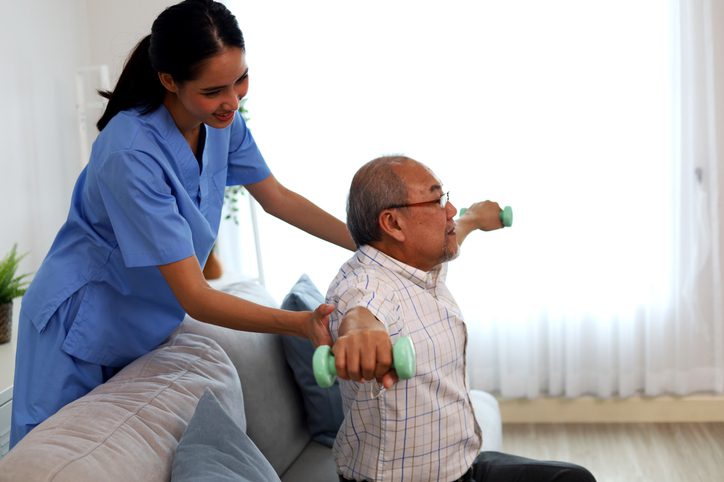Occupational Therapy Technology: Enhancing Client Care
Occupational therapy technology has revolutionized the field, offering innovative tools and approaches to enhance client care. From virtual reality simulations to wearable sensors, technology empowers therapists to tailor interventions, promote […]

Occupational therapy technology has revolutionized the field, offering innovative tools and approaches to enhance client care. From virtual reality simulations to wearable sensors, technology empowers therapists to tailor interventions, promote engagement, and achieve optimal outcomes for individuals with diverse needs.
This exploration delves into the evolution, types, benefits, challenges, and future trends of occupational therapy technology. We’ll examine how technology transforms assessment, intervention, and research, empowering therapists to provide personalized and effective care.
Challenges and Ethical Considerations of Technology in Occupational Therapy

The integration of technology in occupational therapy presents a plethora of opportunities to enhance patient care and outcomes. However, it’s crucial to acknowledge and address the potential challenges and ethical considerations that arise from this integration.
Challenges of Using Technology in Occupational Therapy Practice
The use of technology in occupational therapy practice comes with its own set of challenges. These challenges are often related to the implementation, accessibility, and impact of technology on the therapeutic process.
- Cost and Access: Acquiring and maintaining technology, including software, hardware, and training, can be financially demanding. This can create disparities in access to technology-assisted therapy for patients from different socioeconomic backgrounds.
- Technical Proficiency: Both therapists and patients need to be adequately trained and proficient in using the technology effectively. This can be a barrier for therapists who are less tech-savvy and for patients who may have limited digital literacy.
- Data Security and Privacy: The collection and storage of patient data using technology raise concerns about data privacy and security. Ensuring the confidentiality and integrity of patient information is paramount.
- Dependence on Technology: Overreliance on technology can potentially limit the development of essential skills that are not directly addressed through technology-based interventions. A balanced approach is crucial to foster both technological and traditional therapeutic skills.
- Lack of Standardization: There is a lack of standardized guidelines and protocols for using technology in occupational therapy practice. This can lead to inconsistent application and evaluation of technology-assisted interventions.
Ethical Considerations Related to Data Privacy, Accessibility, and Responsible Use
Ethical considerations are crucial when integrating technology into occupational therapy practice. It’s essential to ensure that technology is used responsibly, equitably, and with respect for patient autonomy and privacy.
- Data Privacy: Therapists must prioritize patient data privacy by implementing secure data storage and access protocols. They should obtain informed consent from patients regarding data collection, use, and sharing.
“Data privacy is paramount in occupational therapy practice, ensuring that patient information is protected and used responsibly.”
- Accessibility: Technology should be accessible to all patients, regardless of their physical, cognitive, or socioeconomic limitations. Therapists should consider the accessibility needs of diverse patient populations and select technology that is inclusive and user-friendly.
- Responsible Use: Technology should be used ethically and responsibly. Therapists should avoid using technology for purposes that are not in the best interest of the patient. They should also be mindful of the potential biases and limitations of technology and use it as a tool to enhance, not replace, human interaction and therapeutic judgment.
Potential Biases and Limitations of Technology in Occupational Therapy
Technology in occupational therapy is not without its limitations and potential biases. These limitations can influence the effectiveness and inclusivity of technology-assisted interventions.
- Algorithmic Bias: Algorithms used in technology-based interventions may contain biases that can perpetuate existing inequalities. For example, an algorithm designed to assess cognitive function may not accurately reflect the cognitive abilities of individuals from diverse cultural backgrounds.
- Lack of Contextual Understanding: Technology may not always be able to fully capture the nuances of human interaction and the complexities of individual experiences. Therapists should supplement technology-based interventions with their clinical judgment and understanding of the patient’s unique context.
- Oversimplification of Complex Tasks: Technology may oversimplify complex tasks, potentially hindering the development of higher-level skills. Therapists should carefully consider the appropriateness of technology-based interventions and ensure that they promote the development of functional and meaningful skills.
Future Trends in Occupational Therapy Technology
The field of occupational therapy is constantly evolving, and technology plays a crucial role in shaping its future. As technology continues to advance, it will create new opportunities for occupational therapists to provide innovative and effective interventions. This section will explore some of the key trends and emerging technologies that are likely to have a significant impact on the practice of occupational therapy in the years to come.
Emerging Technologies, Occupational therapy technology
The integration of emerging technologies in occupational therapy holds immense potential to enhance client care and facilitate meaningful participation in daily life. Here are some key areas where technology is poised to revolutionize the field:
- Artificial Intelligence (AI) and Machine Learning: AI-powered tools can analyze vast amounts of data, personalize treatment plans, and predict outcomes, potentially leading to more efficient and effective interventions. AI can also be used to develop assistive devices that adapt to individual needs and provide real-time feedback on performance. For example, AI-powered robots can be used to assist with tasks such as dressing, eating, and mobility, while virtual reality (VR) simulations can be used to create realistic scenarios for practicing daily living skills.
- Virtual Reality (VR) and Augmented Reality (AR): VR and AR technologies are transforming the way occupational therapists assess and treat clients. VR environments can be used to simulate real-life situations, allowing therapists to observe client performance and provide feedback in a safe and controlled setting. For example, VR can be used to help individuals with anxiety practice social interactions or to help people with balance problems improve their stability. AR can overlay digital information onto the real world, providing clients with real-time feedback and guidance. This technology can be used to assist with tasks such as cooking, driving, and navigation.
- Internet of Things (IoT): The IoT connects everyday objects to the internet, allowing them to collect and share data. This technology can be used to monitor client activity, track progress, and provide personalized interventions. For example, smartwatches and fitness trackers can be used to collect data on client movement and sleep patterns, while smart home devices can be used to adjust the environment to meet individual needs. The integration of IoT devices in occupational therapy can enable continuous monitoring and data-driven interventions.
- Wearable Technology: Wearable devices, such as smartwatches and fitness trackers, are becoming increasingly popular and have the potential to revolutionize occupational therapy. These devices can collect data on a client’s movement, heart rate, and sleep patterns, providing valuable insights into their overall health and functional abilities. Wearable technology can be used to monitor progress, provide feedback, and motivate clients to engage in therapeutic activities.
- Telehealth: Telehealth technologies allow occupational therapists to provide services remotely, using video conferencing and other digital tools. This approach is particularly beneficial for clients who live in rural areas or have difficulty accessing traditional therapy services. Telehealth can be used for assessments, interventions, and follow-up care, enabling greater access to occupational therapy services.
Vision for the Future
The future of occupational therapy is bright, with technology playing a pivotal role in shaping the field. In the coming years, we can expect to see a significant increase in the use of technology to enhance client care, improve outcomes, and expand access to services. Occupational therapists will need to embrace these technological advancements and develop the skills necessary to integrate them effectively into their practice. The goal is to create a future where technology empowers occupational therapists to provide personalized, effective, and accessible care to all clients.
Examples of Technology in Occupational Therapy Practice: Occupational Therapy Technology
Technology has become an integral part of occupational therapy practice, enhancing the delivery of services, improving outcomes, and expanding the reach of interventions. This section explores various technological applications in occupational therapy, illustrating their diverse roles in addressing the needs of clients across different areas of practice.
Examples of Technology in Occupational Therapy Practice
The use of technology in occupational therapy is becoming increasingly prevalent, offering a wide range of tools and resources that can be tailored to meet the unique needs of individuals. This table provides a comprehensive overview of various technologies commonly employed in occupational therapy practice:
| Technology Name | Description | Application in Occupational Therapy | Benefits |
|---|---|---|---|
| Telehealth | The use of technology to deliver healthcare services remotely, such as video conferencing, online platforms, and mobile applications. | Providing therapy sessions to clients in rural or underserved areas, facilitating home-based rehabilitation, and offering convenient access to care. | Increased accessibility, reduced travel time and costs, improved patient satisfaction, and greater flexibility in scheduling appointments. |
| Virtual Reality (VR) | A technology that creates immersive, interactive experiences using computer-generated environments. | Simulating real-life scenarios to practice functional skills, such as driving, cooking, or navigating public spaces, and promoting motor learning and cognitive rehabilitation. | Engaging and motivating experience, improved motor skills, enhanced cognitive function, and reduced fear or anxiety associated with real-world situations. |
| Assistive Technology (AT) | Devices and systems designed to assist individuals with disabilities in performing daily tasks. | Providing adaptive equipment, such as wheelchairs, communication aids, and mobility devices, to enhance independence and participation in daily life. | Increased independence, improved quality of life, enhanced participation in activities, and reduced reliance on caregivers. |
| Wearable Technology | Sensors and devices worn on the body to collect data on movement, activity levels, and physiological parameters. | Monitoring progress in rehabilitation programs, providing feedback on movement patterns, and promoting adherence to exercise routines. | Objective measurement of progress, personalized feedback, increased motivation, and improved adherence to treatment plans. |
Resources and Training for Occupational Therapists

Staying abreast of the latest technological advancements and integrating them into practice is crucial for occupational therapists. Thankfully, a plethora of resources and training opportunities exist to equip therapists with the knowledge and skills needed to effectively utilize technology in their practice.
Professional Organizations
Professional organizations play a vital role in promoting the use of technology in occupational therapy. They offer resources, training, and networking opportunities to help therapists stay informed and connected.
- American Occupational Therapy Association (AOTA): AOTA provides extensive resources on technology, including publications, webinars, and online courses. Their website features a dedicated section on technology, offering insights into current trends and best practices.
- Canadian Association of Occupational Therapists (CAOT): CAOT offers similar resources and training opportunities for Canadian occupational therapists. They actively promote the use of technology in the field and advocate for its integration into practice.
- The Occupational Therapy Association of Australia (OTAA): OTAA provides resources and training for Australian occupational therapists. They focus on promoting the use of technology in various practice areas, including mental health, rehabilitation, and community settings.
Training Programs and Online Platforms
Numerous training programs and online platforms offer comprehensive education on technology in occupational therapy. These programs cover a wide range of topics, including assistive technology, virtual reality, telehealth, and data analysis.
- OTEd: OTEd offers online courses and webinars specifically designed for occupational therapists. They provide training on various technology topics, including virtual reality therapy, assistive technology assessment, and telehealth implementation.
- OT Practice: OT Practice offers a variety of resources and training materials, including online courses and downloadable guides. Their focus is on practical application of technology in real-world settings.
- The University of Southern California (USC): USC offers a Master of Science in Occupational Therapy with a specialization in Assistive Technology. This program provides advanced training in the assessment, selection, and implementation of assistive technology for individuals with disabilities.
Resources for Learning About Technology
Occupational therapists can access a wealth of information and resources to stay informed about the latest advancements in technology. These resources include journals, books, websites, and online communities.
- Journals: Numerous journals dedicated to occupational therapy publish articles on the use of technology in the field. Examples include the American Journal of Occupational Therapy, the Canadian Journal of Occupational Therapy, and the British Journal of Occupational Therapy.
- Books: Several books are available that provide comprehensive information on technology in occupational therapy. These books cover topics such as assistive technology, telehealth, and virtual reality therapy.
- Websites: Websites dedicated to occupational therapy, such as AOTA’s website and OT Practice, offer a wealth of resources, including articles, webinars, and online courses.
- Online Communities: Online communities, such as forums and social media groups, provide a platform for occupational therapists to share knowledge, ask questions, and discuss technology-related topics.
Last Point

As technology continues to evolve, occupational therapy is poised to embrace exciting advancements. The integration of technology into practice offers a transformative path towards enhancing client care, fostering independence, and shaping a future where technology empowers individuals to thrive in their occupations.
Occupational therapy technology is constantly evolving, incorporating innovative tools and approaches to help individuals regain their independence. For instance, the integration of virtual reality in rehabilitation programs is revolutionizing the way therapists engage patients. Similarly, the automotive industry is also embracing technology, as seen in the comparison between the Acura MDX Advance Package and the Technology Package, which can be explored further here.
This type of technological advancement in different fields highlights the importance of adapting to new tools and approaches to improve outcomes.




